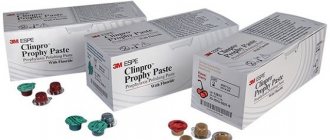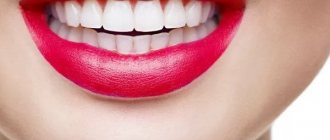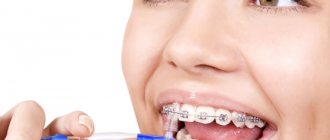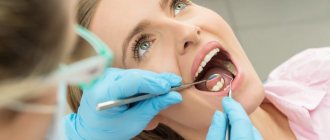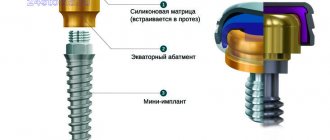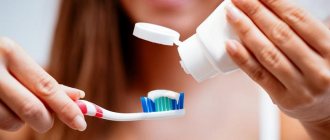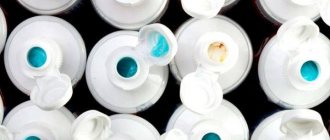What is comprehensive teeth cleaning
Each of us follows basic hygiene rules, including brushing our teeth twice a day. With the help of this simple manipulation, we remove plaque accumulated during the day or night. But the problem is that the interdental spaces and hard-to-reach areas remain uncleaned or not cleaned well enough. As a result, plaque begins to accumulate in these places, and then mineralizes, that is, turns into tartar. It is impossible to remove it with a simple brush and paste. In this case, only professional help from a dentist will help.
The doctor, depending on the type of deposits, may suggest one or another method of cleansing.
The specificity of the instruments used determines the narrow focus of the impact. For example, ultrasonic waves can crush stone, and Air Flow technology can remove soft plaque. Human teeth simultaneously contain both already fossilized and still soft fractions, so for total cleansing it is necessary to use not just one method of professional hygiene, but several procedures in combination. In addition, the enamel layer, having lost its “shell” and has already begun to demineralize underneath, becomes very vulnerable for some time. Therefore, to restore it, it needs recharge, in particular fluorine. Based on the above, we can conclude that only a set of cleaning and protective measures will help your teeth be healthy and beautiful. Comprehensive cleaning includes the following procedures:
- ultrasonic treatment;
- cleansing using Air Flow technology;
- polishing the enamel layer;
- fluoridation.
Why do you need to brush your teeth?
Oral hygiene is not only a matter of aesthetics. It is due to medical reasons. A plaque constantly forms on the enamel, consisting of: • food particles; • saliva; • waste products of microorganisms inhabiting the oral cavity.
The process of plaque deposition does not depend on whether a person ate in the interval between brushings. If it is not removed, over time it turns to stone. Contamination not only creates a cosmetic defect. Deposits contribute to the violation of the integrity of the enamel. Pathogenic bacteria penetrate into the resulting cracks and actively multiply under conditions of poor hygiene. This is how caries begins with all the known consequences. These microorganisms also attack the gums. In people who neglect to brush their teeth, gingivitis becomes chronic. If the inflammation is not treated, complications in the form of periodontitis and periodontal disease are possible. As a result, the root no longer holds in the socket and the tooth falls out.
When is a procedural complex necessary and when it cannot be performed?
Indications for comprehensive cleaning:
- Prevention of caries and periodontal diseases
- Strengthening the enamel layer
- Improving smile aesthetics
- Removing tartar and soft deposits
- Eliminating bad breath
- Before dentures, implantation, installation of braces
- While wearing braces and after removing them
- For crowded teeth
Contraindications:
- Childhood
- Severe cardiovascular diseases
- Presence of a pacemaker
- Difficulty in nasal breathing
- Any disease in the acute period
- Allergy to components of medications used
Indications and contraindications for professional oral hygiene in dentistry
Like any other medical procedure, dental and oral hygiene has its own indications and contraindications. Indications include:
- The presence of soft or hard plaque on the dental surfaces;
- Inflammatory process affecting the gums;
- Presence of tartar;
- Prevention of the development of caries and other dental diseases;
- Enamel pigmentation as a result of smoking, frequent consumption of tea and coffee.
USEFUL TO KNOW: The dental hygiene procedure also helps to brighten them. After all the activities, the teeth brighten by about one to two shades. This is already a good result, but if you need perfect whiteness, then it is better to use an additional service of modern dentistry after hygiene - professional whitening!
Professional dental and oral hygiene must be performed before prosthetics, implantation, orthodontic treatment using braces, installation of veneers and lumineers.
Also, the professional hygiene procedure can be part of complex therapy in the treatment of diseases such as periodontitis and periodontal disease. It is also recommended for expectant mothers to undergo professional cleaning of their teeth and oral cavity in dentistry: during pregnancy, the risks of caries increase significantly and high-quality oral hygiene will be an excellent prevention of this disease!
However, in some cases it is impossible to maintain oral and dental hygiene. For example, with stomatitis, general infectious diseases of the body in acute form. First, it will be necessary to eliminate these diseases and only then will it be possible to undergo the procedure.
Professional oral hygiene is not recommended in case of severe thinning of the enamel or erosion of the enamel coating of the teeth. Under such circumstances, the procedure can do more harm than good!
Indications and contraindications for professional dental and oral hygiene are determined at a dental appointment: the doctor will conduct an examination and tell you whether in your case it is possible to undergo the procedure immediately or whether preliminary measures will be needed that will improve the quality of hygiene and make it as safe as possible for you!
The first stage is ultrasonic treatment
Ultrasound of a certain frequency is capable of coloring tartar into small fragments. Therefore, it is used to remove mineralized deposits on the enamel layer in the supragingival and subgingival zone. This procedure is the first item on a comprehensive list. An ultrasonic scaler destroys stone and, along with it, removes pathogenic microflora in the most inaccessible places of the dentition. Ultrasound is absolutely safe for human health in general and gums in particular. The scaler has an attachment that focuses ultrasound radiation on the area that needs to be treated. The device allows manual adjustment of the intensity of exposure. It is determined by the dentist depending on the conditions of a particular clinical case.
Important: a bonus of using ultrasound is its ability to destroy pathogenic bacteria, i.e., to disinfect the surface being treated. Therefore, dentists strongly recommend performing this procedure for patients with periodontal health problems, not only during a course of treatment, but also regularly to prevent inflammation.
Toothbrush hardness
The stiffness of the brush is determined by the diameter of the fiber - the larger it is, the stiffer the brush will be. Nowadays, manufacturers often indicate the degree of hardness on packaging: very soft (ultra soft, extra soft), soft (soft), medium (medium), hard and very hard (hard).
Very soft brushes are suitable for children under 5 years old and people with sensitive teeth. Soft brushes - for children from 5 to 12 years old, as well as for severe pain in the teeth and gums. Medium hardness brushes are suitable for children over 12 years old and adults.
Hard and very hard brushes are not recommended for use without consulting a doctor. Such brushes can injure the gums and cause abrasion of the hard tissues of the teeth.
Second stage – Air Flow
After removing hard contaminants, it is time for deposits with a soft structure. Cleansing is performed using Air Flow technology. Using a special apparatus, a mixture of water, air and tiny grains of soda is applied to the surface of the patient’s teeth. The abrasive size is so small that it can destroy the bacterial film, but cannot leave scratches on the enamel surface. A stream of abrasive mixture directed under pressure destroys pigmented plaque and immediately washes it away. Thanks to this, the enamel is lightened to its natural tone (by about 1 - 2 shades on the Vita scale).
Note: the process is painless, but may cause slight discomfort for people with hypersensitive enamel. In this case, the doctor may suggest local anesthesia. Patients who are allergic to soda should not perform this cleaning.
How does plaque appear on the tongue?
Let's figure it out from the very beginning - the structure of the body. The tongue is your muscular organ that has a mucous membrane. The structure of the surface of the tongue determines how many bacteria will appear on it. These bacteria, in turn, are the cause of plaque and odor. As is correct, less plaque accumulates on the tip of the tongue because the tip of the tongue is cleaned using natural movement in the oral cavity. The back of the tongue is less mobile. Compared to the anterior one, it only comes into contact with the palate. It is also cleaned less thoroughly by the patient. Therefore, the plaque there is thicker. The reasons for the appearance of plaque on the tongue are obvious:
- Excessive alcohol consumption;
- tobacco and smoking;
- coloring matter from products;
- delay in treating infections;
- chronic diseases;
- stomach problems.
Third stage - polishing
Deposits leave microcracks and irregularities on the enamel layer. Therefore, polishing is necessary after cleaning procedures. Otherwise, the remaining roughness will become a “magnet” for microparticles of food, which will very quickly turn into new deposits. Polishing is performed using abrasive pastes and various attachments driven by a drill. These are polishers, brushes, discs, needle-shaped attachments. The interdental areas are polished with special strips. The process does not cause pain and takes about 40 minutes.
Possible contraindications
Despite the safety of hygienic cleaning, this procedure is contraindicated for some patients. It is not recommended if you have:
- arrhythmias;
- increased sensitivity or erosion of enamel;
- gingivitis;
- acute respiratory diseases.
Dental hygienic treatment is prohibited for pregnant women and adolescents who have not changed their primary dentition to a permanent one. If there are contraindications, the doctor can carry out the procedure manually or using special pastes and attachments for a drill. This will allow you to simultaneously remove deposits and polish the enamel.
The fourth stage - fluoridation
As a rule, fluoridation is not included in the calculation of comprehensive professional hygiene, but it is very important for dental health. The application of fluoride helps strengthen the enamel layer (prevents the leaching of calcium), reduces hypersensitivity, prevents the onset of caries (slows down the proliferation of pathogenic bacteria). Therefore, you should not refuse this procedure. Fluoridation algorithm: the doctor dries the surface to be treated with a warm air stream, then applies fluoride varnish (a harmless composition based on varnish with a high concentration of fluorides) to each element of the dentition, then dries it.
Note: after completing all stages of comprehensive cleansing, teeth become noticeably lighter, reaching their natural natural color. But those patients who dream of a snow-white smile can resort to whitening, for example, using the ZOOM-4 method.
Abrasiveness of toothpaste
Abrasiveness is considered an indicator of the ability of toothpaste to disrupt the structure of enamel and dentin due to abrasion.
The abrasive substances in the paste are responsible for this indicator: silicon compounds, silicon dioxide, hydrated silicon dioxide, or calcium carbonate and calcium phosphate compounds.
A high degree of abrasiveness, although it contributes to high cleaning power, but at the same time causes more damage to tooth enamel. There are 4 levels of toothpaste abrasiveness:
- Low level of abrasiveness - RDA 0-70. Recommended for children and adolescents up to 12-14 years old and adults with hypersensitivity of teeth and gums. For children under 6-7 years of age, an abrasiveness of up to 40 is more suitable. Such pastes have minimal impact on tooth enamel and dentin.
- The average level of abrasiveness is RDA 70-100. This level of abrasiveness is suitable for children from 14 years of age for daily brushing of teeth. Such pastes help maintain the natural color of teeth after professional cleaning and whitening. If you have increased sensitivity of your teeth and gums, it is better to use pastes with low abrasiveness.
- High level of abrasiveness - RDA 100-150. Recommended for people over 14 years old. If you often drink tea, coffee drinks, or tobacco, then periodic use of highly abrasive paste is also suitable for you. When used occasionally and alternating with a paste of medium abrasiveness, it cleans well and does not seriously injure the enamel.
- Very high level of abrasiveness - RDA above 150. Dentists do not recommend using such pastes frequently, as they can cause serious damage to the enamel. Only a specialist can prescribe high abrasive pastes. You must brush your teeth strictly following your doctor's recommendations.
Dentists' tips for caring for your teeth after a comprehensive cleaning
It is in the patient’s interests that the effect of the complex of procedures lasts as long as possible. Therefore, it is important to follow the following recommendations from your dentist in the first few days:
- do not eat or drink for 2 hours after visiting the dentist;
- You should brush your teeth for 3–5 minutes after each meal and at night;
- possible increase in enamel sensitivity. Do not consume food or drinks that are too hot or too cold;
- try not to smoke, tobacco tars eat into the enamel very quickly;
- Reduce (or eliminate) from your diet foods and drinks that contain high amounts of natural and artificial coloring substances.
The dental network offers comprehensive teeth cleaning services. Our clinic offers family and savings discounts. Doctors are highly qualified and improve their skills in leading dental clinics in Russia and Europe. The level of services provided meets international standards.
Branches of our orthodontic center are located in Moscow within walking distance from the metro:
- Art. Alekseevskaya (VDNKh district, etc. Mira), address: st. 3rd Mytishchiskaya house 3, building 2;
- Art. Shelepikha, address: Shelepikhinskaya embankment, address: building 34, building 1.
We will make your teeth strong, beautiful and healthy! Come and see for yourself.
How often should I clean?
Dentists have a unanimous opinion on the issue of frequency of teeth cleaning. The procedure should be performed 1-2 times a year, but not more often, so as not to damage the enamel.
It is necessary to take into account the individual characteristics of the body - for some it is enough to clean the stone once a year, while for another person plaque formation occurs faster, and he needs to visit the dental clinic once every six months.
In addition, professional teeth cleaning is indicated before prosthetics, implantation and dental treatment, as well as before teeth whitening. A clean tooth surface will allow the dentist to do his job better:
- better choose the color of the filling, crown or veneer;
- notice the onset of caries in time;
- prevent many gum diseases;
- achieve good treatment and whitening results.
This manipulation is recommended for those people who smoke and often drink drinks with dyes (tea, coffee, wine, etc.).
